Sitting on a bus bound for Heping Island (和平島), at the start of my first visit to Keelung in years, I was hell-bent on visiting a place of considerable historical interest, even though I knew that it wasn’t officially open to the public.
In 2011, archaeologists working in the densely populated southern half of the island unearthed the foundations of the Convento de Todos los Santos (Convent of All Saints, 諸聖教堂), a Catholic house of worship established during Spain’s 1624-1642 occupation of northern Taiwan. I’d heard about its rediscovery a while ago, but it wasn’t until I read a scholarly tome about European missionaries in Taiwan in the 17th century (and reviewed it for this newspaper, “Languages of conversion,” July 24) that I resolved to see it sooner rather than later.
A few minutes after stepping off the number 102 Bus, I was gazing at what remains of the church. On Ping 1st Road (平一路), the words “Keelung Todos los Santos Church 諸聖教堂考古遺址” were obscured by a parked car, but what lay on the other side of the low wall looked like a typical archaeological site. The entrance was locked. I thought about climbing over the thigh-high barrier, but decided against it. You never know who might be looking, or whether they’re inclined to call the police.
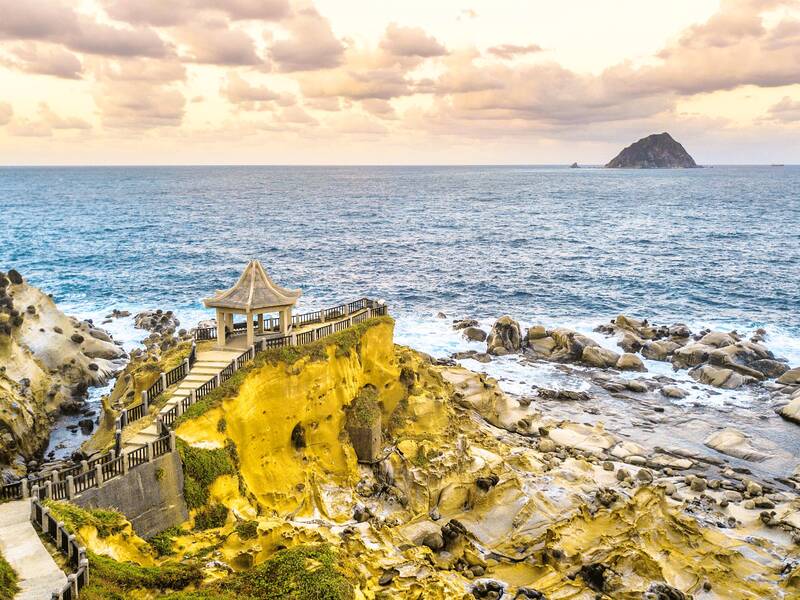
Photo courtesy of the Heping Island Park
So I sauntered down Lane 25, hoping there’d be another way in. Very soon I found one — and I didn’t even have to step over or push aside obstacles.
One part of the foundations is protected by an open-sided metal shelter. Another is covered by a tarpaulin slung over a frame. The boardwalks and most of the bilingual information panels installed for the safety and convenience of visitors are still in place. It seems the church faced south-southwest, toward Zhengbin Fishing Harbor (正濱漁港), a set of wharfs now famous for its eye-catching Color Houses (彩色街屋).
One panel explains that a rectangular feature isn’t a church remnant but actually a septic tank installed during the 1895-1945 period of Japanese colonial rule, when a dormitory for shipyard workers stood here. According to the text, the three-section tank turned human feces into high-quality fertilizer.
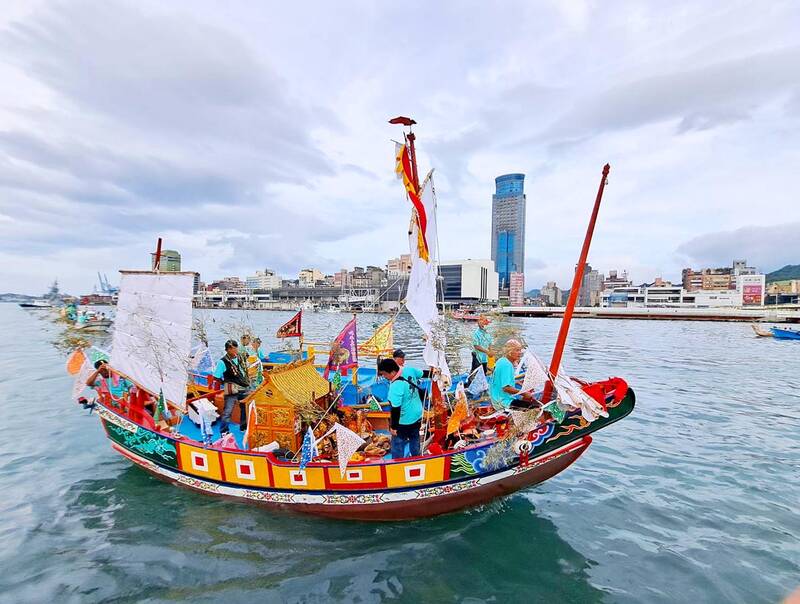
Photo courtesy of Yin Te-gen
It’s conjectured that the church’s strong buttresses were designed to withstand more than just the earthquakes and typhoons that plague this part of the world. It’s likely that it was built, like other Spanish churches in Asia, in the expectation that it might have to serve as shelter for civilians during a military assault on the settlement. There must have been quite a bit of space inside, as the Dutch briefly confined around 400 captives inside it after seizing Spain’s Taiwan outposts.
Another information panel speculates that the stone used in the church’s construction came from somewhere along the Tamsui River, not from Heping Island.
Having looked at the foundations from every angle and taken plenty of photos — and conscious that I shouldn’t stay too long in case someone decided to alert the authorities — I left the way I’d come in and wandered toward the Ministry of Agriculture’s Fisheries Research Institute (農業部水產試驗所, TFRIN).
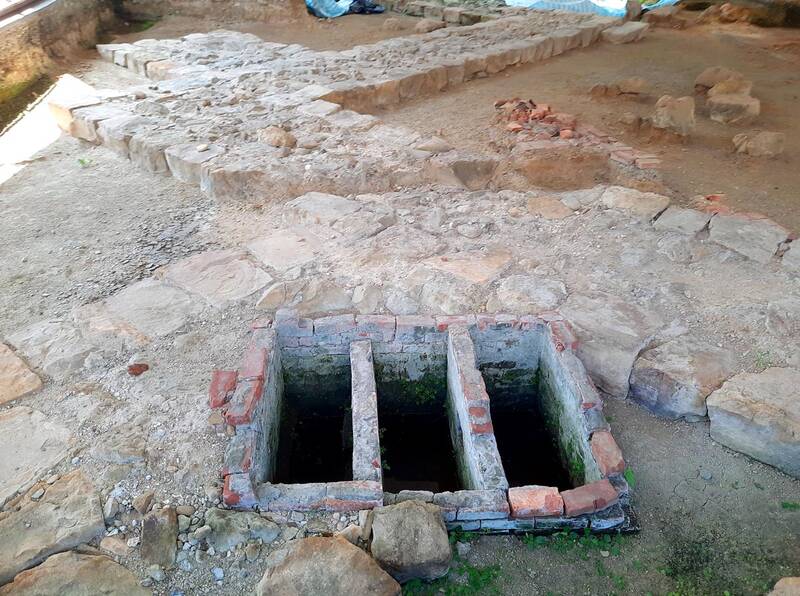
Photo: Steven Crook
Keen to take in views of and from the docks, I walked along Lane 131 of He 1st Road (和一路). To the west, one of TFRIN’s vessels, the imaginatively-named Fishery Researcher I, was tied up.
To the east, I came across old buildings housing fisheries-related businesses, then a pair of rusting hulks. The tools lying around and the rectangles that had been cut out of bulkheads made me wonder if someone was engaged in a long and somewhat dangerous game of Jenga: removing piece after piece, presumably so they could sell the metal, while hoping the ship they were working on wouldn’t suddenly sink.
It was a baking hot day and I needed to refill my water bottle, so I headed to a shrine I’d noticed earlier at 144 He 1st Road. I didn’t find a water machine inside Sheling Temple (社靈廟), but it did have a “king’s boat” (王船) like those that are set afire during elaborate triennial ceremonies in places like Donggang (東港) in Pingtung County.
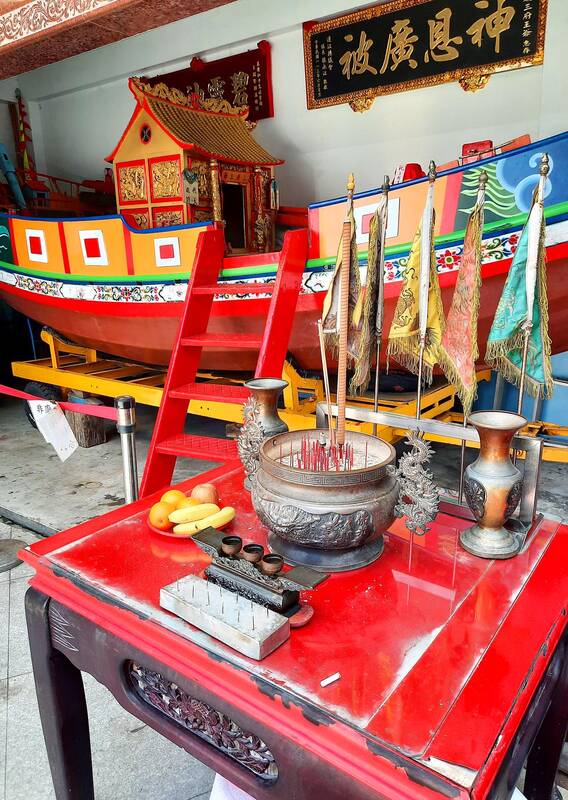
Photo: Steven Crook
Sheling Temple honors three Wangye (王爺) spirits, ranked in precedence: Lin (林), Wen (溫), and Fu (傅). The vessel kept in its annex isn’t especially large and there are no plans to burn it. What’s more unusual — but I didn’t find this out until after my visit — is that it’s made of plastic. When the previous “king’s boat” was decommissioned because it had so thoroughly decayed, the temple’s management committee decided its replacement should be made of materials less susceptible to rot.
As you’d expect in a community where many people make a living from the ocean, there’s a place of worship dedicated to the sea goddess Mazu. Sheliao Tianhou Temple (社寮天后宮) gets its name because Heping Island was known as Sheliao Island until 1946. The shrine has existed at the foot of one of the island’s hills since 1747, but you’d never guess that because in 1996 it was rebuilt from scratch. The temple’s official address is 16, Lane 84, He 1st Road.
There’s nothing very special about the halls where devotees offer incense to Mazu, Taoist immortal Lu Dong-bin (呂洞賓), and the Medicine Buddha. Long ago, the main Mazu effigy provided a remedy for dysentery, though I’ve not been able to understand how: Did the faithful rub paper on it, then consume the paper? Or did they remove a flake of wood to make a decoction? The Chinese explanations I’ve looked at have left me none the wiser.
I was about to leave when I spotted a sign showing the way to the Dragon God Shrine (龍神殿). It appeared to point to a retaining wall right behind the temple’s main building. When I poked my head into the narrow space between the temple and the wall — the aperture was exactly as wide as my foot is long — I saw a simple altar with a 2D image of a whiskery dragon.
According to a worshipper who saw me emerging from the gap, this section of the complex propitiates an ultra-local spiritual entity which made its existence known during Sheliao Tianhou Temple’s reconstruction.
I didn’t grasp all of his explanation, but it reminded me of stories I’ve heard elsewhere: Work begins at a site, but things keep going wrong, so a religious specialist is called in; he determines that a spirit has been disturbed and prescribes appropriate rites; once the supernatural being has been placated, work proceeds without a hitch.
Maybe I’ll try this approach the next time I hit a wall with my writing.
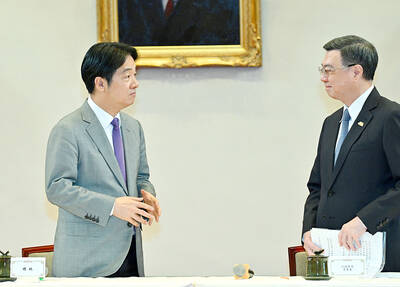
Under pressure, President William Lai (賴清德) has enacted his first cabinet reshuffle. Whether it will be enough to staunch the bleeding remains to be seen. Cabinet members in the Executive Yuan almost always end up as sacrificial lambs, especially those appointed early in a president’s term. When presidents are under pressure, the cabinet is reshuffled. This is not unique to any party or president; this is the custom. This is the case in many democracies, especially parliamentary ones. In Taiwan, constitutionally the president presides over the heads of the five branches of government, each of which is confusingly translated as “president”

Sept. 1 to Sept. 7 In 1899, Kozaburo Hirai became the first documented Japanese to wed a Taiwanese under colonial rule. The soldier was partly motivated by the government’s policy of assimilating the Taiwanese population through intermarriage. While his friends and family disapproved and even mocked him, the marriage endured. By 1930, when his story appeared in Tales of Virtuous Deeds in Taiwan, Hirai had settled in his wife’s rural Changhua hometown, farming the land and integrating into local society. Similarly, Aiko Fujii, who married into the prominent Wufeng Lin Family (霧峰林家) in 1927, quickly learned Hoklo (commonly known as Taiwanese) and

The low voter turnout for the referendum on Aug. 23 shows that many Taiwanese are apathetic about nuclear energy, but there are long-term energy stakes involved that the public needs to grasp Taiwan faces an energy trilemma: soaring AI-driven demand, pressure to cut carbon and reliance on fragile fuel imports. But the nuclear referendum on Aug. 23 showed how little this registered with voters, many of whom neither see the long game nor grasp the stakes. Volunteer referendum worker Vivian Chen (陳薇安) put it bluntly: “I’ve seen many people asking what they’re voting for when they arrive to vote. They cast their vote without even doing any research.” Imagine Taiwanese voters invited to a poker table. The bet looked simple — yes or no — yet most never showed. More than two-thirds of those

In the run-up to the referendum on re-opening Pingtung County’s Ma-anshan Nuclear Power Plant last month, the media inundated us with explainers. A favorite factoid of the international media, endlessly recycled, was that Taiwan has no energy reserves for a blockade, thus necessitating re-opening the nuclear plants. As presented by the Chinese-language CommonWealth Magazine, it runs: “According to the US Department of Commerce International Trade Administration, 97.73 percent of Taiwan’s energy is imported, and estimates are that Taiwan has only 11 days of reserves available in the event of a blockade.” This factoid is not an outright lie — that